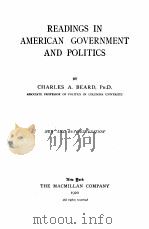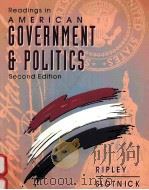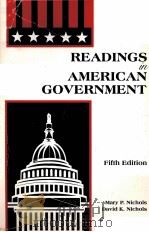《INTRODUCTORY READINGS IN CANADIAN GOVERNMENT & POLITICS》
| 作者 | ROBERT M.KRAUSE 编者 |
|---|---|
| 出版 | COP CLARK PITMAN LTD |
| 参考页数 | 412 |
| 出版时间 | 没有确切时间的资料 目录预览 |
| ISBN号 | 无 — 求助条款 |
| PDF编号 | 811860548(仅供预览,未存储实际文件) |
| 求助格式 | 扫描PDF(若分多册发行,每次仅能受理1册) |

CHAPTER 1. The Dynamics of Canadian Political Culture(s)1
The Making of Canadian Political Culture: An Overview3
Interpretations of Canadian Political Culture6
The Dynamics of Canadian Political Culture9
The Quebec Dynamic10
The Regional Dynamic12
The Continental Dynamic15
The Challenges Facing Canadian Political Culture17
CHAPTER 2. IDEOLOGIES24
Liberalism26
Neoconservatism30
Socialism35
Nationalism37
Populism37
Conclusion38
CHAPTER 3. THE LIVING CONSTITUTION41
The Constitution: Law and Convention42
The Living Constitution42
Constitutional Law43
Constitutional Conventions45
Federalism and the Politics of Regionalism46
Judicial Development of Federalism47
Non-Judicial Development of Federalism49
The Charter of Rights and Freedoms51
The Legislative Override Controversy54
The Charter at Work56
The Meech Lake Accord60
Opposition to Meech Lake61
The Old Constitution versus the New63
Conclusion: Canada's Unresolved Question: Who Shall Govern?64
CHAPTER 4. THE ATLANTIC PROVINCE: AN ENIGMA?70
The Setting71
History72
Economic Development73
Maritime Union76
Political Culture and Parties77
Institutional Structure81
Conclusion81
CHAPTER 5. THE EVOLUTION OF QUEBEC86
Traditional Quebec87
The Quiet Revolution90
The Turbulence of the 1970s92
The 1980s: A New Entrepreneurism96
CHAPTER 6. ONTARIO: CANADA WRIT SMALL102
The Setting of Centrality103
Regionalism104
Party System105
Premier, Cabinet, Bureaucracy: The Apex of Power107
The Ontario Legislature108
Public Policy110
Ontario in the Canadian Federation112
Summary114
CHAPTER 7. WESTERN CANADA119
One Region or Two?119
Setting121
History: A Different Kind of Frontier121
Economy: Benevolent Dependency123
Demography: A Regional Unlike the Others126
Politics: Conformity and Radicalism128
Federalism and the West130
The Problem of Representation130
Conclusion133
CHAPTER 8. FEDERALISM AND FEDERAL-PROVINCIAL RELATIONS136
Unitary, Federal, and Confederal States137
A Parliamentary System and Federalism139
Why a Federal System?139
Summary142
The Evolution of Federal-Provincial Relations142
Federal-Provincial Relations Since World War II144
The History of Shared-Cost Programs145
Conclusion151
CHAPTER 9. PRIME MINISTER AND CABINET154
The Prime Minister157
Cabinet159
Central Agencies162
Prime Minister's Office162
Privy Council's Office166
Federal-Provincial Relations Office167
Department of Finance and Treasury Board Secretariat168
Cabinet Committees170
Cabinet Memoranda175
Conclusion176
CHAPTER 10. THE FEDERAL PUBLIC SERVICE: STRUCTURE AND PERSONNEL180
Organizational Structure181
Departments182
Regulatory Agencies183
Crown Corporations185
Crown Corporation Issues187
Personnel Relations and Administration189
Patronage/Merit Appointment Systems189
Representative Bureaucracy191
Political Rights of Public Servants193
Concluding Observations194
CHAPTER 11. TIES THAT BIND: PARLIAMENTARY MEMBERS AND THEIR CONSTITUENCIES198
The Recruitment Environment199
Public Expectation: A Culture of Local Representation201
Local Constituency Associations and the Nomination Process204
The Single Member Plurality Electoral System206
The Work Environment210
Career Structure and Opportunities210
Role of Legislators in the Policy Process213
Support Services215
Conclusions216
CHAPTER 12. PUBLIC POLICY AND POLICY-MAKING IN CANADA221
The Agenda and Discourse of Policy-Making225
Power and Public Policy228
Pluralism229
Public Choice230
Canadian Political Economy232
Statism234
The Pattern of Public Policy236
The Scope of Public Policy237
The Choice of Policy Instrument239
Who Benefits, and Who Pays?241
Conclusion243
CHAPTER 13. ORGANIZED INTERESTS248
The Legitimacy of Interest Group Activity248
Policy Advocacy and Policy Participation252
The Organizational Development of Groups256
The Impact of Government Structure on Groups258
Interest Groups in Action259
Organized Interests and the Supreme Court261
Conclusion263
CHAPTER 14. MASS MEDIA IN CANADIAN POLITICS: A SURVEY OF CONTEMPORARY ISSUES268
Roles of Mass Media in Democratic Systems271
Freedom of the Press272
Media Ownership275
Foreign Media Penetration277
International Reporting279
Conclusion282
CHAPTER 15. CANADIAN POLITICAL PARTIES288
Parties and the Electorate290
The Canadian Party System290
Parties in Government292
The Party as Organization293
Local Constituency Organizations295
Campaign Organizations296
Conclusion299
CHAPTER 16. THE CANADIAN VOTER303
Volatility and Discontent305
Parties and Their Images308
The Voter Decides311
Into the Nineties316
CHAPTER 17. THE ADMINISTRATION OF JUSTICE322
Adjudication323
The Common Law System324
The Civil Law System326
The Canadian Court Structure327
Judges332
Appointments332
Training335
Impartiality335
Discipline and Accountability337
The Decision-Making Process338
Trail Courts338
Appeal Courts339
The Supreme Court of Canada340
Does Our Justice System Need Reform?341
CHAPTER 18. ISSUES IN MUNICIPAL GOVERNMENT347
Municipal Organization349
Supplying and Paying for Municipal Services353
Education-The Other Municipal Government358
Policing360
Environmental Issues361
Development and Municipal Politics363
Municipal Politicians and Elections365
CHAPTER 19. CANADA AND THE WORLD371
Peace and Security371
The Problem371
The Response372
The Contemporary Challenges374
Economic Growth and Independence377
The Problem377
The Response379
The Contemporary Challenges381
The Environment384
The Problem384
The Response385
The Contemporary Challenges387
Social Justice388
The Problem388
The Response390
The Contemporary Challenges391
Conclusion394
《INTRODUCTORY READINGS IN CANADIAN GOVERNMENT & POLITICS》由于是年代较久的资料都绝版了,几乎不可能购买到实物。如果大家为了学习确实需要,可向博主求助其电子版PDF文件(由ROBERT M.KRAUSE COP CLARK PITMAN LTD 出版的版本) 。对合法合规的求助,我会当即受理并将下载地址发送给你。
高度相关资料
-

- READINGS IN AMERICAN GOVERNMENT AND POLITICS NEW AND REVISED EDITION
- 1920 THE MACMILLAN COMPANY
-

- Language : introductory readings
- 1977 St. Martin's Pressa
-

- READINGS IN AMERICAN GOVERNMENT
- 1991 West Publishing Company
-

- REASON AT WORK INTRODUCTORY READINGS IN PHILOSOPHY
- 1984 COPYRIGHT
-

- COMPARATIVE GOVERNMENT AND POLITICS AN INTRODUCTORY ESSAY IN POLITICAL SCIENCE
- 1968 HARPER & ROW PUBLISHERS
-

- SOCIOLOGICAL FOOTPRINTS INTRODUCTORY READINGS IN SOCIOLOGY SIXTH EDITION
- 1994 WADSWORTH PUBLISHING COMPANY
-

- READINGS IN AMERICAN GOVERNMENT
- 1999 WADSWORTH PUBLISHING COMPANY
-

- READINGS IN AMERICAN GOVERNMENT AND POLITICS SECOND EDITION
- 1993 WADSWORTH PUBLISHING COMPANY
-

- READINGS IN INTRODUCTORY PSYCHOLOGY
- 1973 BURGESS PUBLISHING COMPANY
-

- READINGS IN AMERICAN GOVERNMENT FIFTH EDITION
- 1996 KENDALL/HUNT PUBLISHING COMPANY
-

- THE CANADIAN ECONOMY:SELECTED READINGS
- 1961 MACMILLAN
-

- POLITICS AND GOVERNMENT IN MALAYSIA
- 1978 FEDERAL PUBLICATIONS
提示:百度云已更名为百度网盘(百度盘),天翼云盘、微盘下载地址……暂未提供。➥ PDF文字可复制化或转WORD


